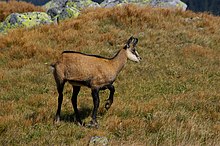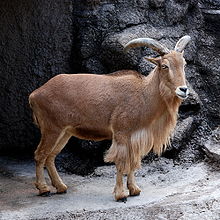Goat-like
| Goat-like | ||||||||||||
|---|---|---|---|---|---|---|---|---|---|---|---|---|

Taiwan Serau ( Capricornis swinhoei ) |
||||||||||||
| Systematics | ||||||||||||
|
||||||||||||
| Scientific name | ||||||||||||
| Caprini | ||||||||||||
| Gray , 1821 |
The goat-like (Caprini) are a tribe of the horned bearers (Bovidae). This group includes the sheep and goats (including the ibex ) and their close relatives such as chamois and musk ox . The group includes around 63 living species .
General
Compared to other horn-bearers, goats are medium-sized, compactly built animals with stocky limbs. They are adapted to mountainous and sometimes polar habitats. With the exception of the Tschiru , both sexes have horns, but in some species such as sheep and goats, the males are significantly larger than those of the females. Other species, however, show hardly any sexual dimorphism .
In contrast to most of the other subfamilies of the hornbearing goats, the main distribution area is not in Africa but in Eurasia, where they predominantly inhabit mountainous habitats. In Africa they are only represented with a few species; some representatives also occur in North America.
Systematics
The system of goat-like species is not undisputed, especially within the sheep and goat genera there are differences in the number of species. The following system largely follows Groves & Grubb 2011:
|
Internal systematics of the Caprini according to Zurano et al. 2019
|




- Tribus Caprini
Gray , 1821
- Genus Pantholops Hodgson , 1834
- Tschiru ( Pantholops hodgsoni ( Abel , 1826))
- Genus Oreamnos Rafinesque , 1817
- Mountain goat ( Oreamnos americanus ( de Blainville , 1816))
- Genus Takine ( Budorcas Hodgson , 1850)
- Goldtakin ( Budorcas benfordi Thomas , 1911)
- Mishmi-Takin or Takin ( Budorcas taxicolor Hodgson , 1850)
- Sichuan takin ( Budorcas tibetana Milne-Edwards , 1874)
- Bhutan takin ( Budorcas whitei Lydekker , 1907)
- Genus Ammotragus Blyth , 1840
- Great barbary sheep ( Ammotragus lervia ( Pallas , 1777))
- Genus Arabitragus Ropiquet & Hassanin , 2005
- Arabian tahr ( Arabitragus jayakiri ( Thomas , 1894))
- Genus Hemitragus Hodgson , 1841
- Himalayan tahr ( Hemitragus jemlahicus ( CH Smith , 1826))
- Genus blue sheep ( Pseudois Hodgson , 1846)
- Blue sheep ( Pseudois nayaur ( Hodgson , 1833))
- Dwarf blue sheep ( Pseudois schaeferi Haltorth , 1963)
- Genus goats ( Capra Linnaeus , 1758)
- Wild goat or bezoar goat ( Capra aegagrus Erxleben , 1777); the domestic goat was domesticated from this species
- West Caucasian Ibex or Kuban-Tur ( Capra caucasica Güldenstedt & Pallas , 1783)
- East Caucasian Ibex or Dagestan-Tur ( Capra cylindricornis ( Blyth , 1841))
- Screw goat or markhor ( Capra falconeri ( Wagner , 1839))
- Alpine ibex ( Capra ibex Linnaeus , 1758)
- Nubian Ibex or Syrian Ibex ( Capra nubiana F. Cuvier , 1825)
- Iberian ibex ( Capra pyrenaica Schinz , 1838)
- Siberian ibex ( Capra sibirica ( Pallas , 1776))
- Ethiopian ibex ( Capra walie Rüppell , 1835)
- Genus Nilgiritragus Ropiquet & Hassanin , 2005
- Nilgiri-Tahr ( Nilgiritragus hylocrius ( Ogilby , 1838))
- Genus sheep ( Ovis Linnaeus , 1758)
- Altai wild sheep ( Ovis ammon ( Linnaeus , 1758))
- Oman wild sheep ( Ovis arabica Sopin & Harrison , 1986)
- Tajikistan wild sheep ( Ovis bochariensis Nasonov , 1914)
- Bighorn sheep ( Ovis canadensis Shaw , 1804)
- Kazakhstan wild sheep ( Ovis collium Severtzov , 1873)
- Afghan Urial Sheep or Turkmenistan Wild Sheep ( Ovis cycloceros Hutton , 1842)
- Dall Sheep ( Ovis dalli Nelson , 1884)
- Gobi wild sheep ( Ovis darwini Przewalski , 1883)
- Armenian wild sheep ( Ovis gmelini Blyth , 1841)
- Tibet Argali ( Ovis hodgsoni Blyth , 1841)
- Isphahan wild sheep ( Ovis isphahani Nasonov , 1910)
- North China Wild Sheep or North China Argali ( Ovis jubata Peters , 1876); probably extinct
- Tienshan-Argali ( Ovis karelini Severtzov , 1873)
- Laristan wild sheep ( Ovis laristanica Nasonov , 1909)
- Karatau wild sheep ( Ovis nigrimontana Severtzov , 1873)
- Snow Sheep ( Ovis nivicola Eschscholtz , 1829)
- Wild sheep ( Ovis orientalis ); the domestic sheep was domesticated from this species
- Pamir Argali ( Ovis polii Blyth , 1841)
- Punjab wild sheep ( Ovis punjabiensis Lydekker , 1913)
- Kyzylkum wild sheep ( Ovis severtzovi Nasonov , 1914)
- Ladakh wild sheep ( Ovis vignei Blyth , 1841)
- Genus chamois ( Rupicapra de Blainville , 1816)
- Anatolian chamois or Asia Minor chamois ( Rupicapra asiatica Lydekker , 1908)
- Carpathian chamois ( Rupicapra carpatica Couturier , 1938)
- Abruzzo chamois ( Rupicapra ornata Neumann , 1899)
- Cantabrian chamois ( Rupicapra parva Cabrera , 1911)
- Pyrenean chamois ( Rupicapra pyrenaica Bonaparte , 1845)
- Chamois or Alpine chamois ( Rupicapra rupicapra ( Linnaeus , 1758))
- Genus Myotragus Bate , 1909
- † Cave goat ( Myotragus balearicus Bate , 1909)
- Genus Gorale ( Naemorhedus C. H. Smith , 1827)
- Red goral or Tibetan goral ( Naemorhedus baileyi Pocock , 1914)
- West Himalayan goral ( Naemorhedus bedfordi ( Lydekker , 1905))
- Long-tailed goral or North China goral ( Naemorhedus caudatus ( Milne-Edwards , 1876))
- Burma goral ( Naemorhedus evansi ( Lydekker , 1905))
- Gray goral or East Himalayan goral ( Naemorhedus goral ( Hardwicke , 1825))
- Chinese goral or West China goral ( Naemorhedus griseus ( Milne-Edwards , 1871))
- Genus Seraue ( Capricornis ogilby , 1837)
- Japanese serau ( Capricornis crispus ( Temminck , 1844))
- Indochinese serau ( Capricornis maritimus Heude , 1888)
- Chinese serau ( Capricornis milneedwardsii David , 1869)
- Red serau ( Capricornis rubidus Blyth , 1863)
- Southern Serau or Sumatra Serau ( Capricornis sumatraensis ( Bechstein , 1799))
- Taiwan Serau or Fomosa Serau ( Capricornis swinhoei Gray , 1862)
- Himalaya Serau or Nepal Serau ( Capricornis thar ( Hodgson , 1831))
- Genus Ovibos de Blainville , 1816
- Musk ox ( Ovibos moschatus ( Zimmermann , 1780))
- Genus Pantholops Hodgson , 1834
The affiliation of the Tschiru was long disputed. It was sometimes placed with the gazelle- like or separated into its own subfamily, Panthalopinae. Molecular studies confirmed that it belongs to the goat-like species. Equally controversial were two species that were previously classified as goat-like: the saiga , which is now classified as a gazelle-like, and the Vietnamese forest cattle , which is now part of the Bovinae . The Tahre were early considered members of a single genus ( Hemitragus ), but they show genetically different relationships.
literature
- Colin Groves and Peter Grubb: Ungulate Taxonomy. Johns Hopkins University Press, 2011, pp. 1–317 (SS 108–280)
- Colin P. Groves and David M. Leslie Jr .: Family Bovidae (Hollow-horned Ruminants). In: Don E. Wilson and Russell A. Mittermeier (eds.): Handbook of the Mammals of the World. Volume 2: Hooved Mammals. Lynx Edicions, Barcelona 2011, ISBN 978-84-96553-77-4 , pp. 444-779
- DE Wilson, DM Reeder: Mammal Species of the World . Johns Hopkins University Press, Baltimore 2005. ISBN 0-8018-8221-4
Individual evidence
- ↑ Juan P. Zurano, Felipe M. Magalhães, Ana E. Asato, Gabriel Silva, Claudio J. Bidau, Daniel O. Mesquita and Gabriel C. Costa: Cetartiodactyla: Updating a time-calibrated molecular phylogeny. Molecular Phylogenetics and Evolution 133, 2019, pp. 256-262.
- ↑ Fayasal Bibi: A multi-calibrated mitochondrial phylogeny of extant Bovidae (Artiodactyla, Ruminantia) and the importance of the fossil record to systematics. BMC Evolutionary Biology 13, 2013, p. 166.
- ^ Anne Ropiquet and Alexandre Hassanin: Molecular evidence for the polyphyly of the genus Hemitragus (Mammalia, Bovidae). Molecular Phylogenetics and Evolution 36, 2005, pp. 154-168.
Web links
- Goat-like on ultimateungulate.com (English)